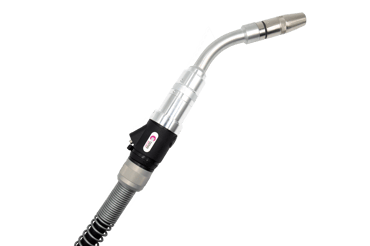Robotic MIG welding requires a choice between which type of welding torch to use in your operation. The option between water-cooled and air-cooled torches requires weighing the pros and cons because making your decision. Each torch has its benefits and downfalls that can alter the productivity of your operation.
In this blog, we will detail the most common problems and solutions when dealing with an air-cooled welding torch solution.
The Basics
Air-cooled robotic welding torches can be efficient and productive when used within their limits. With sufficient evaluation, an air-cooled torch may be the best choice for your operation. Generally speaking, air-cooled torches are best used in low duty-cycle, low-amperage, and thinner material applications.
When it comes to robotics, an air-cooled torch can be chosen as an over-arm or through-arm robot design. Torch necks, also known as swannecks, are available in 22, 45, and 180 degree bends to create optimal performance for your needs.
Compared to a water-cooled torch, you will not be required to purchase as much equipment to perform the duties of the torch.  The water cooler needed for a water-cooled torch ads additional expenses and maintenance to your process.
The water cooler needed for a water-cooled torch ads additional expenses and maintenance to your process.
Let’s take a look at two common problems you will likely encounter with your robotic air-cooled MIG gun.
When the Problem is Overheating…
The most commonly reported performance issue with air-cooled robotic torches is overheating. Overheating can cause a realm of issues that are detrimental to your operation. For starters, this can cause quick replacement of your front-end neck parts. Contact tips may not last through an entire weld cycle when overheating occurs. Nozzles, contact tips, and tip holders will all need replaced before they normally would.
It is important that the torch is being used correctly, in terms of rating, shielding gas, and amperage. Further, with continued use, excess heat can migrate upward causing breakdown of the torch cable. If torch rotation parameters are exceeded, cable failures will result. The image below shows the rotational parameters that the torch should not exceed. Simply, either the torch application was not rated correctly initially or the additional applications exceed the torch’s capability.
When The Problem Is Tool Center Point (TCP) Inaccuracy…
Another performance issue that can develop with air-cooled torches is TCP inaccuracy. If the neck is not positioned correctly to the weld, the weld will not end up in the right place. This could happen if the neck has been “crashed” or there is wear in the neck/torch interface. Crashing the neck may be solved with re-programming of the robot.
Binzel necks are built to be resistant to damage, with an aluminum armor covering.
Neck wear may occur if repeated neck change is being done. A dual locking keyway on the front module will help prevent any neck misalignment.
One thing you can do to help with neck exchange is to correctly use the shielding collar on the neck. Rotating the collar to cover the sets screws will prevent weld spatter from damaging access to the two set screws.

In Conclusion
Robotic air-cooled welding torches have a number of operational benefits to consider when deciding if this torch type is right for you. With any benefit, there comes a downside. Take the time to outweigh the good and bad before making your decision. The more you know about your new equipment, the better.
Knowing how to handle new equipment is the key to being successful. If you can get ahead of some of the major air-cooled robotic welding gun pain points, that can help your productivity in the long run.
Interested in learning more information about robotic welding torches? Check out our Definitive Guide to Robotic Welding Torches by clicking the button below.

/Headshots/Johnson_Dale.jpg)
